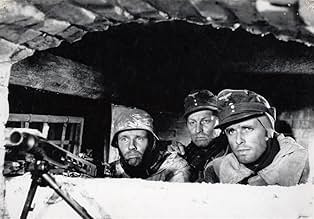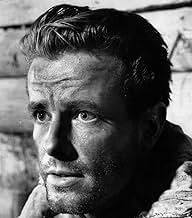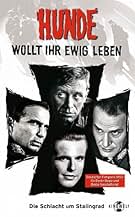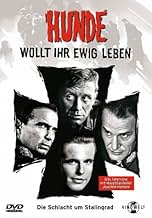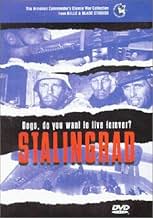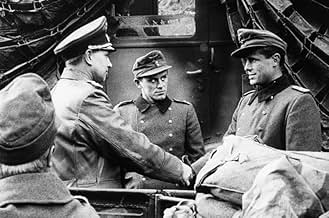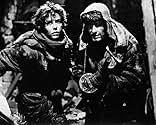Im Winter 1943 setzt sich ein junger deutscher Leutnant vor dem Hintergrund von Schlachtszenen mit dem Konzept des Krieges auseinander, der der unmenschlichen Nazi-Ideologie immer mehr misst... Alles lesenIm Winter 1943 setzt sich ein junger deutscher Leutnant vor dem Hintergrund von Schlachtszenen mit dem Konzept des Krieges auseinander, der der unmenschlichen Nazi-Ideologie immer mehr misstraut.Im Winter 1943 setzt sich ein junger deutscher Leutnant vor dem Hintergrund von Schlachtszenen mit dem Konzept des Krieges auseinander, der der unmenschlichen Nazi-Ideologie immer mehr misstraut.
- Auszeichnungen
- 3 Gewinne & 3 Nominierungen insgesamt
Empfohlene Bewertungen
Made soon after the few survivors of Stalingrad returned home, wounds were still fresh & deep when this film was released just 14 years after the unconditional surrender. This film is important because was one of the first German post-war films to critically examine some very difficult & painful areas for the Germans.
Interestingly we never see Hitler's face - I'm sure there are a few reasons for that. The film addresses the lie that the Allies of Germany, Rumania (and Italy et al for that matter) were poor troops. They were good soldiers but were indeed poorly equipped & supported.
There have been criticisms for mis-matching of stock footage, incorrect tanks (T-34/86 instead of T-34/76) & subtitling. Most of this is minor, for example mistaking "Oberst-Leutenant" (Lt-Col) for "Oberleutenant" (Snr Lt) and mis-spelling General Hoth's name (as "Hooth"). The translating of "break-out" as "break ranks" is trivial. The actual footage spliced in may be of different battles but given the time & place this was made it seems a reasonable thing to do. In the end, getting squashed by a Russian tank or disintegrated by high explosive shells is much the same experience wherever you do it.
No, 14 years was not long enough for a deep introspection but this film made a solid start down that path. Well worth seeing. Look out for the exceedingly & implausibly beautiful Sonja Ziemann.
Interestingly we never see Hitler's face - I'm sure there are a few reasons for that. The film addresses the lie that the Allies of Germany, Rumania (and Italy et al for that matter) were poor troops. They were good soldiers but were indeed poorly equipped & supported.
There have been criticisms for mis-matching of stock footage, incorrect tanks (T-34/86 instead of T-34/76) & subtitling. Most of this is minor, for example mistaking "Oberst-Leutenant" (Lt-Col) for "Oberleutenant" (Snr Lt) and mis-spelling General Hoth's name (as "Hooth"). The translating of "break-out" as "break ranks" is trivial. The actual footage spliced in may be of different battles but given the time & place this was made it seems a reasonable thing to do. In the end, getting squashed by a Russian tank or disintegrated by high explosive shells is much the same experience wherever you do it.
No, 14 years was not long enough for a deep introspection but this film made a solid start down that path. Well worth seeing. Look out for the exceedingly & implausibly beautiful Sonja Ziemann.
The truth scene between Germans and Russians is alone a masterpiece, because authentic and of course never showed in JJ Annaud's crap, made in 2001, ENEMY AT THE GATES, a Hollywood garbage junk supposed to show the real face of war, but only a warmonger feature, not an anti war one. I HATE most of American movies about WW2, not every one, but at least 90 percent. This one deserves to be discovered again. It is available on you tube. A real masterpiece. Both sides provided real heroes. BOTH SIDES. And the thing I admire the most is that the Russian soldiers, the enemies of the lead German characters, are not shown as bad guys, as German soldiers are shown in Russian war features. See? THIS IS DEFINITELY NOT A F...PROPAGANDA CRAP. That's why I love it. Truly, definitely. Absolutely.
This unfairly obscure early German World War II movie has a lot going for it. For one, it has a solid cast with a lot of recognizable German actors who went on to be in a lot of international productions (namely Preiss and Frank) and put in some solid performances here as soldiers trapped in a hopeless battle.
There's a solid share of action with everything on display from the Romanian units crumbling under tank assault to General von Manstein's attempt at relieving the pocket to the bitter street fighting up to the end. Actually the street fighting comes off even better than in STALINGRAD and ENEMY AT THE GATES and feels quite authentic and realistic despite the low budget. Maybe it's because a good share of the actors in the film actually served in the war? I assume the producers were able to find a section of a German city still devastated from the war some 14 years later or else it's some very good set design. Either way I'm impressed. Amazingly, they even managed to round up some real hardware with at least two real T-34's and a PAK anti tank gun for the battle scenes.
The film takes the ingenious step of using authentic stock footage to supplement the battle scenes as was possible only back when films were black and white. This trick also worked well in ITALIANI BRAVA GENTE which also managed to often call into doubt whether the combat footage was original or stock.
The only main detractor is a lot of mismatched stock footage often from entirely different battles (including some now-famous shots of the retreat from Moscow) and during different times of the year (winter to summer and back again). The film tries to play it off by making it look like snow doesn't hit until after the Russians cut off Stalingrad, but anyone with a basic knowledge of WW2 history should know better. Also the tanks are off, with T34/85's appearing too early in the war as usual and a rare case where an IS2 briefly subs in for a German tank of some sort. Mostly minor nitpicks considering that the film's budget was so low. It's amazing what they were able to pull off with such scant resources.
There's a solid share of action with everything on display from the Romanian units crumbling under tank assault to General von Manstein's attempt at relieving the pocket to the bitter street fighting up to the end. Actually the street fighting comes off even better than in STALINGRAD and ENEMY AT THE GATES and feels quite authentic and realistic despite the low budget. Maybe it's because a good share of the actors in the film actually served in the war? I assume the producers were able to find a section of a German city still devastated from the war some 14 years later or else it's some very good set design. Either way I'm impressed. Amazingly, they even managed to round up some real hardware with at least two real T-34's and a PAK anti tank gun for the battle scenes.
The film takes the ingenious step of using authentic stock footage to supplement the battle scenes as was possible only back when films were black and white. This trick also worked well in ITALIANI BRAVA GENTE which also managed to often call into doubt whether the combat footage was original or stock.
The only main detractor is a lot of mismatched stock footage often from entirely different battles (including some now-famous shots of the retreat from Moscow) and during different times of the year (winter to summer and back again). The film tries to play it off by making it look like snow doesn't hit until after the Russians cut off Stalingrad, but anyone with a basic knowledge of WW2 history should know better. Also the tanks are off, with T34/85's appearing too early in the war as usual and a rare case where an IS2 briefly subs in for a German tank of some sort. Mostly minor nitpicks considering that the film's budget was so low. It's amazing what they were able to pull off with such scant resources.
10wuf0170
This refers to the English subtitled release of this film.
This film deals with a tragic defeat and the destruction of the 6th Army at Stalingrad. It was produced shortly after the German POWs taken at Stalingrad had returned home, so had to deal with a critical and knowledgeable audience. It also walked a tightrope, delivering an anti-war message and condemning German leadership in a country which was sick unto death of finger pointing and criticism.
The events in the film take place over more than four months. In order to tell the story coherently, the film shifts focus from narrative to vignette. As the story nears its end, the focus narrows and remains with the troops trapped in Stalingrad, starving and written off by Hitler. All in all, it is well told and the acting is quite good.
On the downside, whoever did the subtitles could have done a better job. I speak German and seeing the subtitles while hearing the dialog and knowing a bit of the history created a bit of a dissonance. General Hoth's name is repeatedly written "Hooth", breakout (as in a breakout from the encirclement) is translated as "Breaking ranks," OberLeutnant (1st Lieutenant) is written as "Lieut. Col.", and when von Paulus uses the word Meuterie (Mutiny), it is translated as disobedience. I suspect that those who are familiar with the history of the battle for Stalingrad and military ranks, but who don't speak German, may have a bit of a problem. these problems with the subtitles led me to give this movie 4 instead of 5 stars.
Still, the story is well told and survives the translator's bludgeon. I was left wanting a bit more. Few films these days manage that.
This film deals with a tragic defeat and the destruction of the 6th Army at Stalingrad. It was produced shortly after the German POWs taken at Stalingrad had returned home, so had to deal with a critical and knowledgeable audience. It also walked a tightrope, delivering an anti-war message and condemning German leadership in a country which was sick unto death of finger pointing and criticism.
The events in the film take place over more than four months. In order to tell the story coherently, the film shifts focus from narrative to vignette. As the story nears its end, the focus narrows and remains with the troops trapped in Stalingrad, starving and written off by Hitler. All in all, it is well told and the acting is quite good.
On the downside, whoever did the subtitles could have done a better job. I speak German and seeing the subtitles while hearing the dialog and knowing a bit of the history created a bit of a dissonance. General Hoth's name is repeatedly written "Hooth", breakout (as in a breakout from the encirclement) is translated as "Breaking ranks," OberLeutnant (1st Lieutenant) is written as "Lieut. Col.", and when von Paulus uses the word Meuterie (Mutiny), it is translated as disobedience. I suspect that those who are familiar with the history of the battle for Stalingrad and military ranks, but who don't speak German, may have a bit of a problem. these problems with the subtitles led me to give this movie 4 instead of 5 stars.
Still, the story is well told and survives the translator's bludgeon. I was left wanting a bit more. Few films these days manage that.
A lot of times I read here by IMBD, that there are only three war-films on the eastern front (Cross of Iron, Stalingrad and Enemy at gates). There are a lot of other european films with this topic and for me this one is the best of all. There are war films better than this, but no one at the eastern front.
Wusstest du schon
- PatzerGerman soldiers carry the Yugoslavian M56 submachine gun instead of the MP40. Yugo M56s are basic copies of the German design, but there are subtle but noticeable differences, such as the long smooth barrel.
Top-Auswahl
Melde dich zum Bewerten an und greife auf die Watchlist für personalisierte Empfehlungen zu.
- How long is Stalingrad: Dogs, Do You Want to Live Forever??Powered by Alexa
Details
- Erscheinungsdatum
- Herkunftsland
- Sprache
- Auch bekannt als
- Stalingrad: Dogs, Do You Want to Live Forever?
- Drehorte
- Produktionsfirma
- Weitere beteiligte Unternehmen bei IMDbPro anzeigen
Box Office
- Budget
- 2.000.000 DM (geschätzt)
- Laufzeit
- 1 Std. 37 Min.(97 min)
- Farbe
- Sound-Mix
- Seitenverhältnis
- 1.66 : 1
Zu dieser Seite beitragen
Bearbeitung vorschlagen oder fehlenden Inhalt hinzufügen

